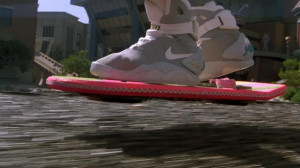
Today—October 21, 2015—is the date the writers of “Back to the Future II” chose as the day their characters would land in their futuristic travels. Journalists are reporting on how well those writers did in predicting state of the art gadgets and gizmos for 2015. It’s fun to see the things they got right—like giant TV screens and video conferencing. And it’s funny to see the things they predicted that either haven’t been invented (yet) or just don’t need to be—like hoverboards and double neckties.
Since the Back to the Future writers were writing in the late 1980s, no one expected them to be completely accurate with their predictions. But those expectations go up incrementally when the writers are writing about the past. Especially in historic fiction, of course, but even when a novel like Cherry Bomb—my fiction story set mostly in the 1980s—takes the reader to places like a night club in New York City, it’s important to research whether or not a “Cosmopolitan” martini had been made yet. And when Mare, the graffiti writer, wears a “hoodie”…. Were they actually called hoodies back then?
Why does it matter so much in a novel? Because you want to “keep the reader safe,” which means to keep them safely into the story line, believing in the setting, the characters, and their adventures. When the details jump out at the reader—seeming to contradict the setting or the time period—they disrupt the flow of the story.
I’m thankful to have writing buddies who critique my work from time to time, and also excellent editors recommended by the literary agent who is now reading the fourth revision of Cherry Bomb. (Fingers crossed that I’ve finally got it right!) It’s hard to recognize these mistakes in our work sometimes because we are so close to the story and the characters that we can’t see that so-and-so couldn’t have made a call on her cell phone in 1985, for example. When I see those kinds of mistakes in books or movies, they pull me away from the enjoyment of the plot.
I have no plans for writing anything futuristic, but my hands are full trying to get the details right in my fiction, and of course in (nonfiction) essays, where getting them right is essential. I’d love to hear from other writers about how they deal with this important issue. Thanks for reading!